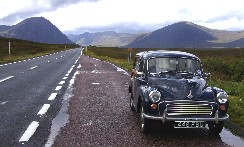Carb and fuel pump question...
Forum rules
By using this site, you agree to our rules. Please see: Terms of Use
By using this site, you agree to our rules. Please see: Terms of Use
Carb and fuel pump question...
I'm just about to install the 950 engine I bought at the National in our traveller. I was going to swap as a whole lump, with all the ancilleries but I've just noticed that the spare carbs I've got are all the later HS2s (probably from 1098s). Are they likely to be cause any problems, or are they fairly interchangeable?
Second question: I noticed when I was checking the new engine over that the cam does actually have a lobe to run a mechanical fuel pump. The Marina engine that was fitted to the van when we got it ran quite happily with its mechanical pump - so is there a reason why the Minor was always fitted with the electric one? They're great when they're working but must be more prone to unreliability than a mechanical.....(the only thing I can think of is that the float isn't built for a constantly 'working' pump?)
Second question: I noticed when I was checking the new engine over that the cam does actually have a lobe to run a mechanical fuel pump. The Marina engine that was fitted to the van when we got it ran quite happily with its mechanical pump - so is there a reason why the Minor was always fitted with the electric one? They're great when they're working but must be more prone to unreliability than a mechanical.....(the only thing I can think of is that the float isn't built for a constantly 'working' pump?)

Re: Carb and fuel pump question...
By the 1940s, the range of fuel pumps being made was more or less down to two: the SU electric, and the AC mechanical. William Morris had bought SU in the 1920s, and although he was happy enough to sell them to Rolls-Royce (Derby Bentleys had used them since the early 30s) I imagine the prospect of helping Austin didn't appeal. Morris, MG, and Wolseley had used SU pumps for many years, so it was natural to continue with a known product. The A Series was, of course, an Austin design, but they must have compromised on mechanical pumps for Austins and electric for Morrises. The mechanical pump isn't actually continuously pumping - like the SU, it's powered (by the cam acting on its lever) to suck, and uses a spring to push.alzax3 wrote: so is there a reason why the Minor was always fitted with the electric one?
Kevin
-
alex_holden
- Minor Legend
- Posts: 3798
- Joined: Tue Jul 25, 2006 9:46 am
- Location: Burnley
- MMOC Member: No
Effectively there's no difference. They both supply fuel at a pressure limited by the strength of the spring acting on the diaphragm. When fuel is used by the carb and the diaphragm in the pump moves, it's pushed back to refill it by either a lobe on the cam or an electromagnet.alzax3 wrote:Thanks for that autolycus - when I said 'continuously pumping' I meant that it pumps independently of the fuel requirements ie: it will still be pumping when the float closes the inlet valve, whereas the SU will shut down at that point until fuel is required again.
The only time there's a difference is when you try to start the engine after a long stand-up and the petrol in the float chamber has all evaporated away. With an electric pump, as soon as you turn the ignition on it goes "chunka chunka chunka" and you're ready to start on the first turn of the engine. With a mechanical pump, you have to turn the engine over several times before enough fuel has got into the carb to start it. Old Land Rovers have a manual lever on the mechanical pump so you can hand-prime the carb before trying to start the engine on the crank handle.


Alex Holden - http://www.alexholden.net/
If it doesn't work, you're not hitting it with a big enough hammer.
Yup, our tractors have those levers too - Being diesels they have a return pipe anyway, which is why I wondered whether they'd have problems without one!
I had a look, all the MOWOG 1098 blocks and the 950 I'm working on have a steel plate over the fuel pump hole - which is there, so it wasn't just the Austins that were made with it....
I had a look, all the MOWOG 1098 blocks and the 950 I'm working on have a steel plate over the fuel pump hole - which is there, so it wasn't just the Austins that were made with it....

-
mike.perry
- Series MM Registrar
- Posts: 10183
- Joined: Sun Jul 24, 2005 11:39 pm
- Location: Reading
- MMOC Member: No
Th HS2 is a better carb - use it! The mechanical pump on the block has the BIG advantage that it doesn't ever get stuck because of fuel evaporation in the lines! Disadvantage as Alex has pointed out - is the need to crank the engine to fill the fuel bowls from scratch - however this has the advantage that it circulates a little oil round the engine before it 'fires' - so every cloud has a silver lining! All Minis from early 80s on used the mechanical pump - it's very very reliable.



Old engine out, (made much quicker by the fact that there were no bolts along the lower edge of the front panel!) Unfortunately someone had done some dodgy (ie bad) repairs on the top of the drivers side tie plate which had been hidden by a layer of oily dust (the whole engine is like that, I knew it was going to have poor compression when we bought it, and when checked it was chugging along at 120 psi - rising to 150 with a squirt of oil. I'll be interested in the state of it when I tear it down!) so I'll have to put in some metal properly before the new engine goes back. That side engine mount tower was poor too, but fortunately I picked that sides one up on a whim at the last car boot sale I went to! 
Last edited by alzax3 on Sun Jul 12, 2009 9:01 pm, edited 1 time in total.
